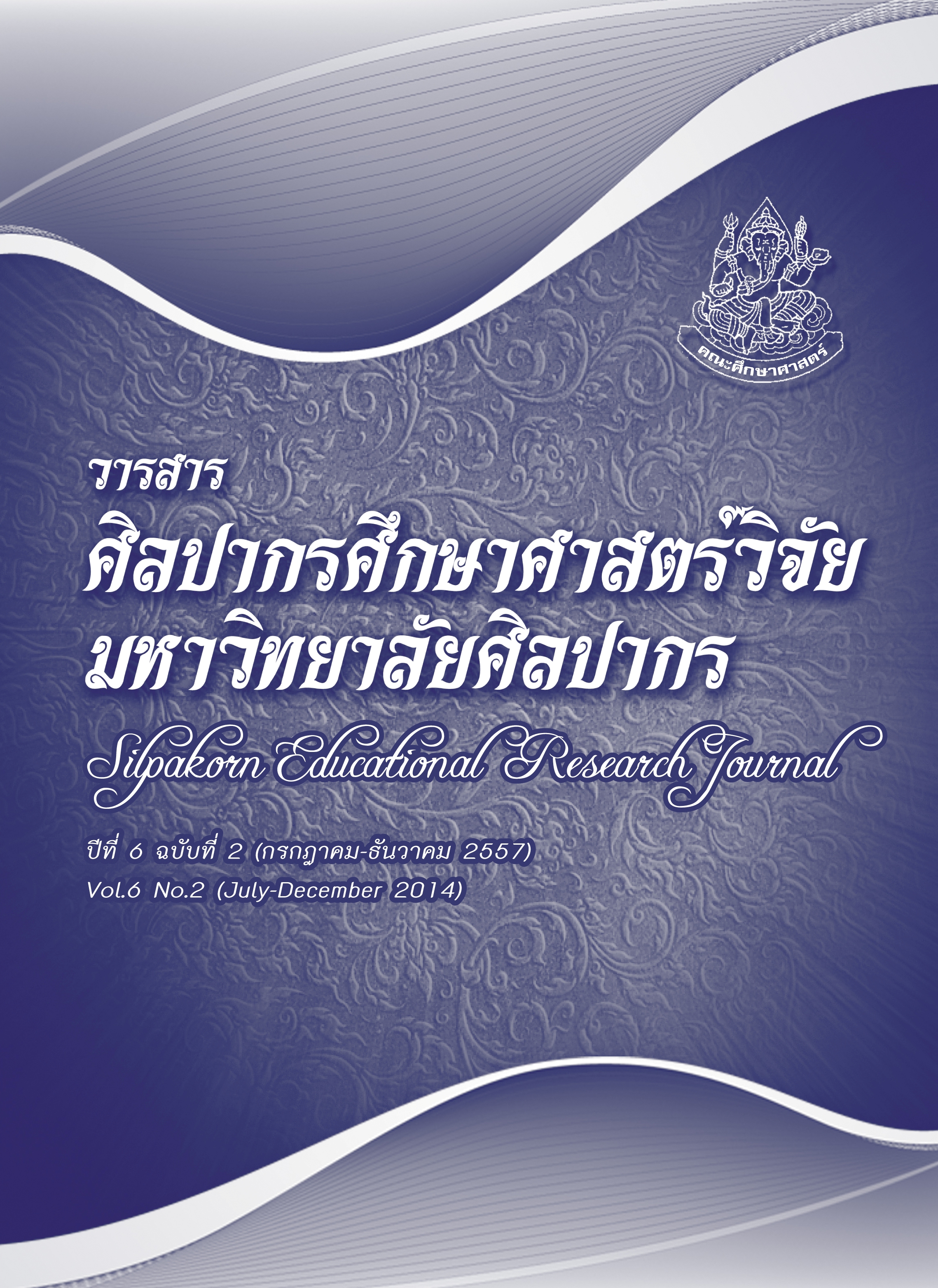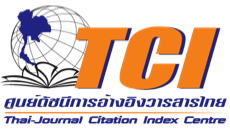รูปแบบการร่วมมือกันพัฒนาวิชาชีพที่ส่งเสริมความเชี่ยวชาญด้านการสอนของอาจารย์ที่พัฒนา ทักษะการคิดขั้นสูงของนักศึกษาในระดับอุดมศึกษา
คำสำคัญ:
รูปแบบการร่วมมือกันพัฒนาวิชาชีพ / ความเชี่ยวชาญด้านการสอน / การพัฒนาวิชาชีพในระดับอุดมศึกษา/ ทักษะการคิดขั้นสูงในระดับอุดมศึกษาบทคัดย่อ
การวิจัยครั้งนี้มีวัตถุประสงค์ คือ 1) เพื่อพัฒนาและตรวจสอบความสมเหตุสมผลของรูปแบบการร่วมมือกันพัฒนาวิชาชีพ 2) เพื่อศึกษาประสิทธิผลของรูปแบบการร่วมมือกันพัฒนาวิชาชีพ ดำเนินการวิจัยด้วยการวิจัยและพัฒนาและประยุกต์ใช้การวิจัยแบบผสมผสานวิธี กลุ่มตัวอย่างได้แก่อาจารย์กลุ่มวิศวกรรมศาสตร์ จำนวน 4 คน และนักศึกษากลุ่มวิศวกรรมศาสตร์ จานวน 318 คน จากมหาวิทยาลัยเทคโนโลยีสุรนารี จังหวัดนครราชสีมา เครื่องมือที่ใช้ในการวิจัย คือ คู่มือการพัฒนาวิชาชีพ แผนการพัฒนาวิชาชีพ แผนการสอน แบบทดสอบ แบบประเมิน แบบบันทึก แบบสังเกต แบบสอบถามและประเด็นการสนทนากลุ่มที่ผ่านการตรวจสอบคุณภาพของเครื่องมือ วิเคราะห์ข้อมูลโดยใช้ ค่าเฉลี่ย ส่วนเบี่ยงเบนมาตรฐาน ค่าร้อยละ การวิเคราะห์เนื้อหาและสถิติแบบไม่อิงค่าพารามิเตอร์โดยการทดสอบอันดับที่มีเครื่องหมายกากับของ วิลคอกซันการทดสอบค่าที และการวิเคราะห์เนื้อหา
ผลการวิจัยพบว่า :
1. รูปแบบการร่วมมือกันพัฒนาวิชาชีพเอสยูทีโกล (SUTGOAL Model) ประกอบด้วยองค์ประกอบ 5 ส่วน คือ หลักการ วัตถุประสงค์ เงื่อนไขการนารูปแบบไปใช้ ปัจจัยสนับสนุน และขั้นตอนการดำเนินการ มีกระบวนการดำเนินการพัฒนาวิชาชีพ 7 ขั้น
2. รูปแบบการร่วมมือกันพัฒนาวิชาชีพเอสยูทีโกล มีความสมเหตุสมผล มีประสิทธิผล คือ ความรู้ความเข้าใจของอาจารย์เกี่ยวกับการสอนที่พัฒนาการคิดขั้นสูงหลังการใช้รูปแบบการร่วมมือกันพัฒนาวิชาชีพสูงกว่าก่อนการใช้รูปแบบการร่วมมือกันพัฒนาวิชาชีพฯ อย่างมีนัยสำคัญทางสถิติที่ระดับ .05 อาจารย์มีพัฒนาการความเชี่ยวชาญด้านการสอนสูงขึ้นตามลำดับทุกคน และ ความสามารถในการคิดขั้นสูงของนักศึกษาสูงกว่าก่อนเรียนอย่างมีระดับนัยสำคัญทางสถิติที่ระดับ .05 และอาจารย์กลุ่มวิศวกรรมศาสตร์ มีความเห็นว่า รูปแบบที่พัฒนาขึ้นส่งเสริมให้เกิดการพัฒนาวิชาชีพและการจัดการเรียนการสอนที่ส่งเสริมการคิดขั้นสูง รวมทั้งนักศึกษากลุ่มวิศวกรรมศาสตร์มีความพึงพอใจต่อการจัดการเรียนการสอนที่ส่งเสริมการคิดขั้นสูงของอาจารย์ระดับมากที่สุด
The purposes of this research were to 1) develop and verify reasonability of a Collaborative Professional Development model and 2) study effectiveness of the developed model. The research and development procedures and mixed method were implemented. One-Group Pretest-Posttest Design) and Equivalent Time-Samples Design was employed. The purposive sampling subjects were 4 faculties , 318 engineering students form Suranaree University of Technology. The research instruments were professional development manual , professional development plan , professional development calendar, lesson plan, achievement test, competency evaluation test, record form, observation form, questionnaire and focus group items. Statistical analysis employed were mean, standard deviation, percentage, non parametric the wilcoxon signed ranks test, dependent t-test and content analysis.
The research findings were:
1. The collaborative professional development model design and development was called “SUTGOAL Model” which consisted of 5 components : principle, objective, model condition, supporting factors and stages of operation. The collaborative professional development procedure could be divided into 7 stages.
2. The consequences of SUTGOAL Model implementation revealed that the SUTGOAL Model was effective with reasonability. Instructional competency enhancing higher order thinking skills of the faculties were higher than before with statistically significant different at the level of .05. All engineering faculties’ teaching expertise were gradually developed a sequence. Engineering students’ higher order thinking skills were higher than before implementation of the model were higher than before with statistically significant different at the level of .05. Engineering faculties agreed that the model that promoted professional development enhancing higher order thinking skill. The Engineering students were satisfied that the instruction which promoted higher order thinking skills at highest level.





